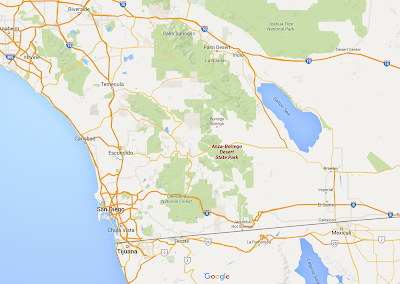I spent most of last week in the desert southwest of the U.S., visiting
Anza Borrego Desert State Park in southern California. I went as part of a Desert Ecology course offered through the UW-Madison Botany Department, my PhD alma mater, and led by my PhD advisor
Tom Givnish and the department's new plant physiological ecologist,
Kate McCulloh. We spent the first part of the week exploring Anza Borrego and the Borrego Springs area, taking field trips as far away as the Salton Sea, Joshua Tree National Park, and Mt. San Jacinto.
You've probably heard that this year is an El Niño year, which has resulted in excess rainfall in this part of the country, and a rare "superbloom" in areas like Death Valley. The flowers were also out in full force in the Anza Borrego area, and we had a wonderful time learning to identify the desert annuals that were in bloom and thinking about their ecology and relation to the landscape. But of course, for me there was another highlight - the ferns! There is actually a large radiation of ferns in the desert southwest, with a suite of adaptations for living in this often punishing environment. We managed to find six species of ferns during our few days there, which isn't a bad haul.
Three of the species we found belong to the genus
Myriopteris, a classic xeric-adapted group of ferns in the family Pteridaceae. Many of the members of this genus formerly belonged to the genus
Cheilanthes, but a beautiful recent study by my fern friend Amanda Grusz, currently a postdoc at the Smithsonian Institution, revealed that the ferns now called
Myriopteris all form a clade, and should therefore be named accordingly. You can find Amanda's great paper on the evolution of this genus
here.
The three species we found are
Myriopteris covillei,
M. parryi, and
M. viscida. In the photos below, you can see some of these ferns' adaptations for desert living, including small stature, and being coated with a dense layer of hairs and/or scales, to slow water loss. They also tend to live in rocky cracks and crevices out of direct sunlight.
 |
| L to R: M. parryi, M. covillei, M. viscida |
 |
| Myriopteris viscida |
 |
| Myriopteris covillei |
 |
| Myriopteris covillei |
 |
| Myriopteris covillei |
 |
| Myriopteris covillei |
 |
| The M. covillei pictured above were found hiding out under these huge rock formations in Joshua Tree |
 |
| Myriopteris parryi |
 |
| Myriopteris parryi |
 |
| Myriopteris parryi |
 |
| Myriopteris parryi |
 |
| Myriopteris parryi |
 |
| The desert just feet away from this population of M. parryi! |





















































